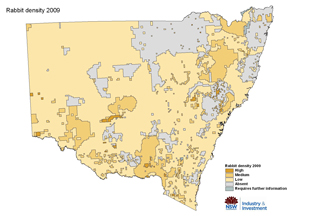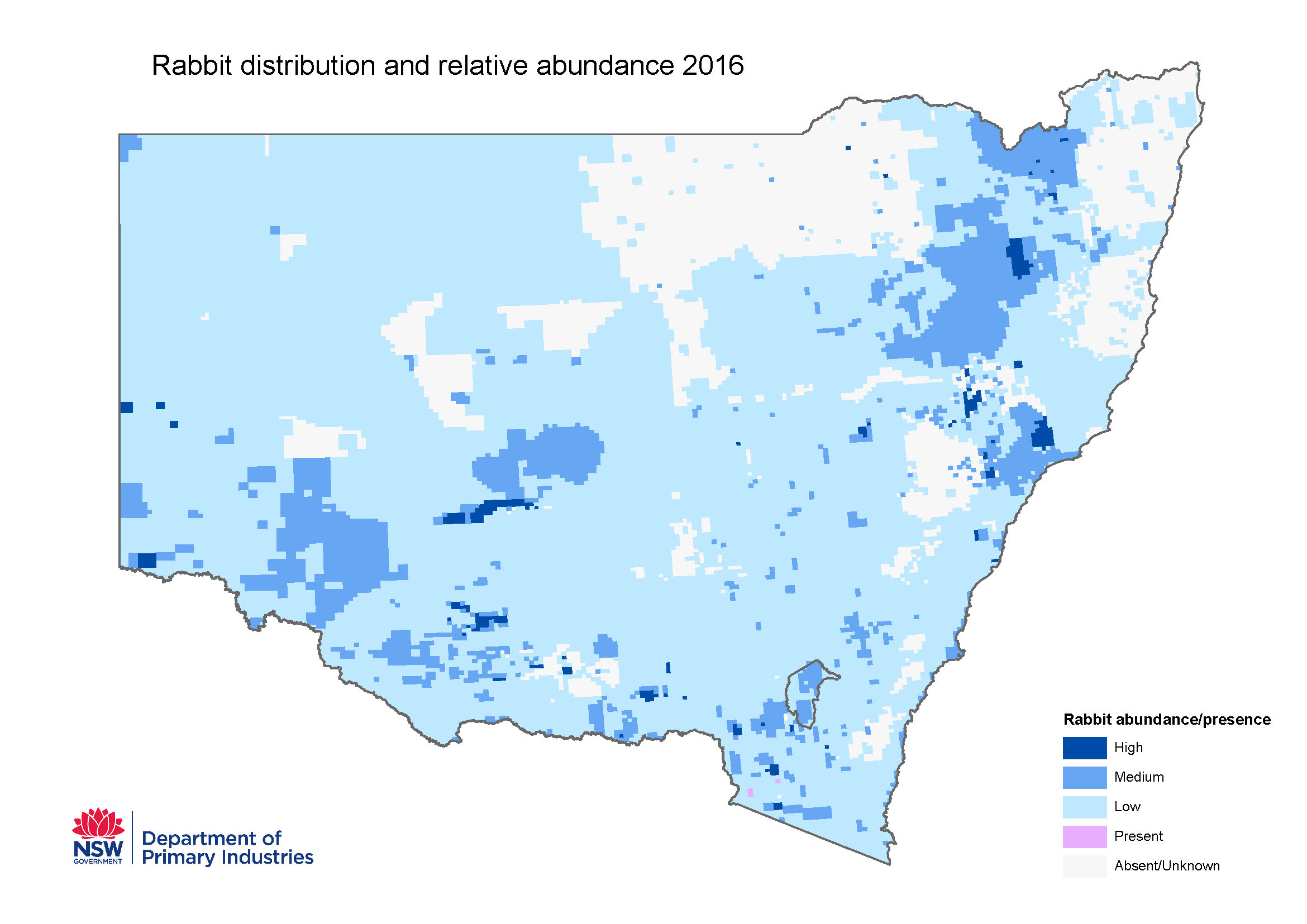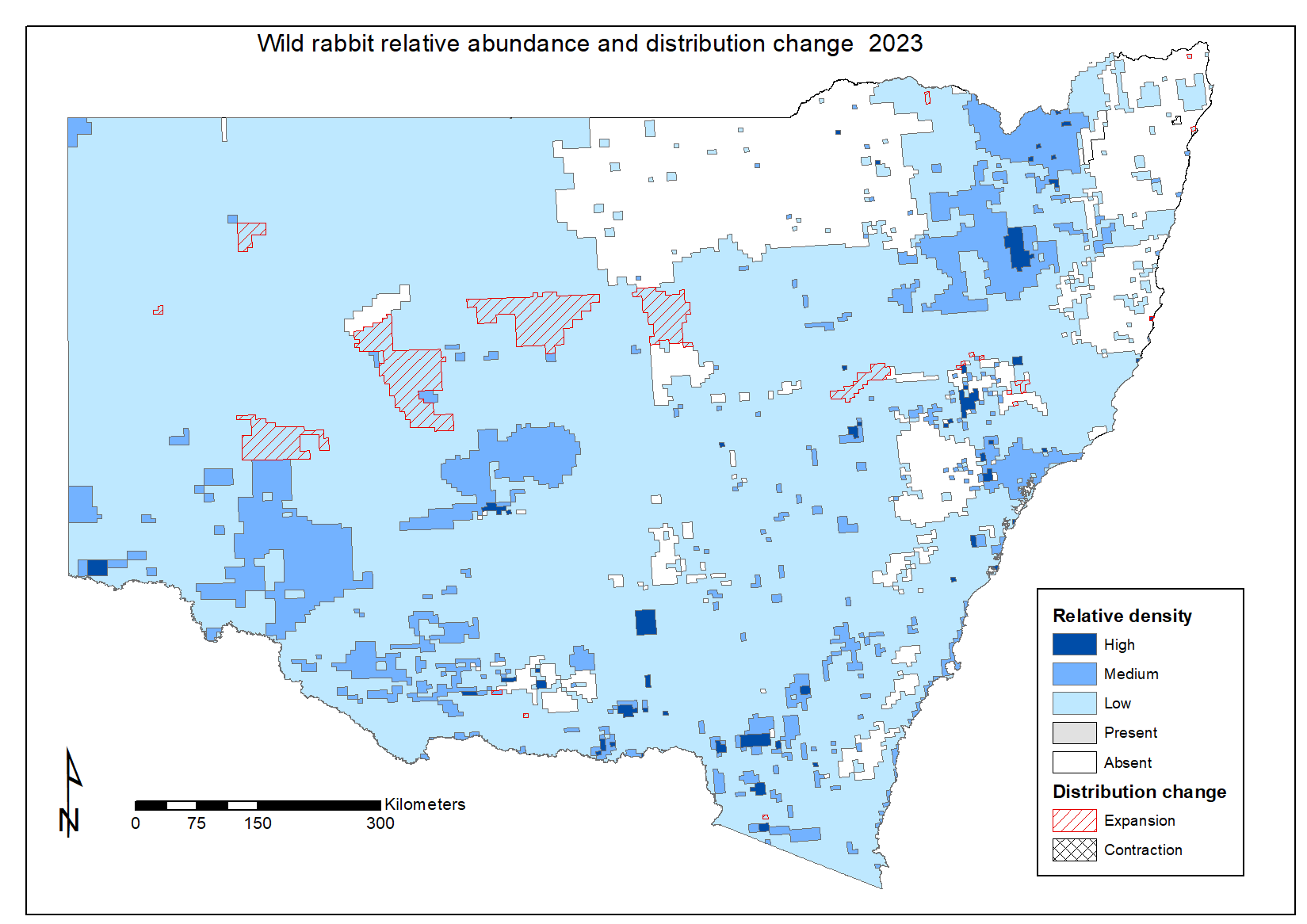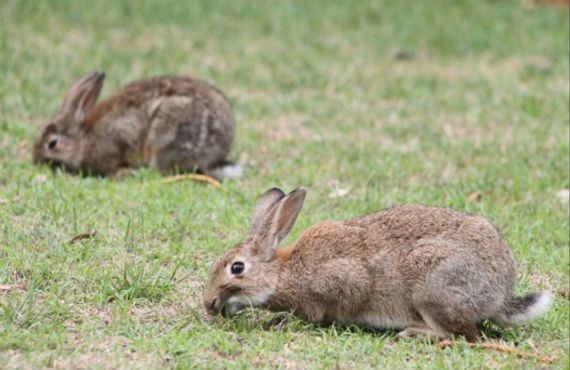
Rabbit biology and distribution
Origin
The European rabbit, Oryctolagus cuniculus, is native to north-western Africa, Spain and Portugal and it is now found in the USA, Chile and most of Western Europe as far north as Scandinavia. Domesticated meat rabbits arrived in Australia with the First Fleet and rabbits were released onto many islands in the Bass Strait and the Tasman Sea to provide sustenance for shipwrecked sailors. The first genetically wild rabbits were imported into Victoria in 1859. This small population of 24 individuals grew to over 20,000 within 6 years.
Rabbits quickly spread across Victoria and the rest of the continent. Within 70 years rabbits inhabited two thirds of the continent. This rate of spread suggests that humans contributed to their distribution. Rabbits now inhabit approximately 5.3 million square kilometres or 70% of southern Australia. They have established in environments ranging from subalpine areas to stony deserts, from subtropical grasslands to wet coastal plains, and particularly in Mediterranean type climates; these are areas generally associated with livestock production or that support the majority of Australia's rural production.
Distribution in New South Wales
The rabbit is found throughout most of this State with the general exception of the black soil areas. Although there is no accurate figure on the present distribution, past surveys indicate that at least three-quarters of the State has some degree of rabbit infestation. Approximately 8% would have a high and extremely detrimental population of rabbits.
Recognition and sign
The only animal in Australia that could be confused with the rabbit is the hare (Lepus capensis). The hare has longer, black-tipped ears, longer legs and a loping gait. Rabbits and hares are most active at dawn and dusk and feed by grazing and browsing.
Rabbit droppings are often similar to hares', depending on the food eaten, but they are distinguished from lamb faeces by the absence of flat facets on the surface. Scrapes, dung heaps, burrows and warrens are evident when rabbits are present.
Habitat
Rabbits prefer short grassy areas either found naturally, as in semi-arid areas, or resulting from heavily grazed pastures. Warrens and/or harbour such as blackberries or fallen logs are often located nearby.
These animals can adapt to a wide variety of habitats, though in general they avoid large cultivated areas, forests, floodplains and black soil country. Human habitation does not deter rabbits and they may become a problem around gardens, shearing sheds and other farm buildings.
Behaviour
Rabbits are most active from late afternoon until early morning, but they can be active at any time if they are undisturbed or if their numbers are high. Activity appears to decrease at night if there are high winds or rain, which limits their ability to detect predators. Daily movements are generally within 150 to 200 m of the warren, but this distance can increase during droughts (up to 1500 m has been observed), or decrease during the breeding season. Communication is mainly by smell, but alarm signals are given by flashing the tail while running and by thumping with the hind feet.
Social structure and breeding
With the onset of breeding, social groups of 7–10 rabbits form, governed by a dominant buck and a dominant doe. There is a high level of aggression, strong territorial behaviour and the development of social hierarchies. The main breeding season is determined primarily by rainfall and the early growth of high protein plants and so varies throughout the State. In the south, it usually starts after autumn and finishes in late spring, whereas in other parts of the State breeding results from the increase in vegetation during spring. Rabbits can breed at any time provided there is short green feed supplying sufficient protein.
Both males and females reach sexual maturity at 3–4 months of age. The gestation period for rabbits is 29–35 days (average 31). The doe generally mates again within an hour of giving birth and under favourable conditions an adult female can produce 7 or 8 litters in a year. Average litter size is 4–5 kittens in the first litter, rising to about 8 by the end of the season. Consequently, one doe can produce between 50–60 offspring in a single breeding season.
The young are usually born in nests of grass and belly fur, which may be in the warren complex or in a breeding stop (the breeding stop is a short single-entrance burrow less than 1 metre long and about 30 cm below ground). Kittens are born blind and hairless. After the birth and first feeding, the doe leaves. She will visit the kittens 4–5 times each 24 hour period for feeding. Kittens eyes open after 7 –10 days and they are weaned and emerge from the warren at about 18 days. They leave the nest at 23 to 25 days old.
Dispersal
Very young rabbits 20 to 60 days old are more likely to disperse than older rabbits. Adult rabbits rarely disperse. Most dispersal is from warrens with a high rabbit density to warrens with a low density or to adjacent social groups. Rabbits usually do not travel vast distances, but movements in excess of 20 km have occasionally been recorded.
Diet
Rabbits are herbivorous and eat a wide variety of plants including crops, roots, pastures, young trees and young vines, and prefer short, succulent plants. With an average body weight of 1.6 kg, a rabbit can consume up to one-third of its own weight daily, with the average daily intake 100 to 150g. Nine rabbits equates to one dry sheep equivalent.
Coprophagy
As part of their digestive process rabbits form two types of faecal pellets: soft and hard. The soft pellets, produced mainly during the day, are eaten directly from the anus. This is called coprophagy. The process is used to extract the remaining protein and moisture from food and allows a more complete digestion of the fibrous plant material. It also enables rabbits to survive with minimum free water. The hard pellets seen on the ground and at dung heaps are the end result of the digestion process and are usually dropped during the normal grazing period from late afternoon and throughout the night.
Mortality
Apart from human-mediated control, natural adult rabbit mortality does not suppress a rabbit population. Kitten mortality in the wild is extremely high, with up to 80% dying before they reach 3 months of age. However, in a favourable year with a temperate Mediterranean climate, 85% mortality is needed to suppress a 10-fold population increase.
Disease: There are currently only two diseases known to heavily impact rabbit populations: myxomatosis (myxo) and rabbit haemorrhagic disease virus (RHDV). Myxomatosis is a pustule forming disease that affects the lymphoid tissue leading to profound immunosupression and generalised systemic disease. Death usually occurs within 8–12 days in acute cases or 3–5 days after clinical signs develop.
RHDV is a calicivirus. Rabbits with RHDV usually develop signs of fever within 36 hours of infection and are often dead within 6–12 hours after the onset of fever. Outwardly, animals that have died from RHDV appear healthy. On occasion a bloody discharge from the nose may be present. RHDV generally only infects adult rabbits.
Both myxo and RHDV were introduced into Australia as biological control agents to suppress rabbit numbers. When each virus was first released (myxo in 1950 and RHDV in 1995) they reduced rabbit populations by up to 98% in some areas. Both diseases are transmitted by insect vectors (flies, mosquitoes and fleas). Neither disease is lethal to any other species and RHDV has never been identified in any other species of animal, including other species of rabbit or hare.
Coccidiosis can also impact rabbits. Coccidiosis is a common worldwide protozoal disease of rabbits that occurs in two forms – hepatic and intestinal. Hepatic coccidiosis is caused by, Eimeria stiedai with intestinal coccidiosis causes by a number of other species of Eimeria. Young rabbits are most susceptible to hepatic coccidiosis with severe infections resulting in death. Intestinal coccidiosis is rarely fatal.
Parasites: Rabbits have few external parasites except fleas. The European and Spanish rabbit fleas, (Spilopsyllus cuniculi and Xenopsylla cunicularis respectively) are important vectors for myxomatosis.
Predation: Predation can account for substantial losses of both healthy and starving rabbits. Besides the fox, dingo, cat and dog there are a number of avian species that prey on the rabbit in Australia. The wedge-tailed eagle is probably the most effective, followed by goshawks, falcons and barn owls. Ravens, goannas and snakes may also prey on kittens.
Benefits
The benefits of rabbits are few. Warrens are utilised by a number of native species including echidnas, goannas and brushtail possums to name a few. Rabbits are also a valuable food source for birds of prey, particularly where the introduction of the rabbit has led to a decline in native fauna. Rabbits were also a valuable resource during the Great Depression, feeding families and providing an income through the sale of skins and meat. And of course, rabbits are the most important ingredient in that Aussie icon, the Akubra.
Impacts
Rabbits inhabit 70% of Australia's landmass (5.3 million km2) and are widespread throughout most locations where they are found. Rabbits impact 75 commonwealth listed threatened plant species and five threatened ecological communities. Rabbits are Australian agricultures most costly pest vertebrate animal: the annual cost exceeds $200 million.
Australian native vegetation is very sensitive to rabbit damage. As few as 0.5 rabbits per hectare can be enough to prevent the regeneration of a number of threatened or endangered plant species. Forestry and tree plantations can also suffer extensive losses due to grazing rabbits.
Erosion caused by denuded vegetation from rabbit grazing has a major impact on dam catchments, water supplies and maintaining topsoil. The burrowing behaviour of rabbits can undermine roads, culverts, buildings and sites of cultural significance.
Rabbits can directly compete in agricultural enterprises with livestock for pasture. This may result in running fewer livestock; lower wool clips and breaks in the wool, lower reproduction rates, lower weight gains and possibly earlier deaths during drought. Indirectly reduced lambing rates may occur due to higher fox numbers being maintained by a high rabbit population.
Rabbits have also played a role in the extinction native species. There have been no known native mammal extinctions north of the range of the rabbit since European settlement. Most of the extinctions that occurred within the rabbits range occurred after the rabbit arrived but before the fox arrived. Rabbits may not have been the main cause of extinction for these species, but they are strongly implicated.
Competition and grazing by rabbit is listed as a Key Threatening Process (KTP) under the Threatened Special Conservation Act 1995.
Distribution map 2009
 Click map for larger view (PDF, 214.67 KB)
Click map for larger view (PDF, 214.67 KB)
Distribution map 2016
 Click map for larger view (PDF, 420.16 KB)
Click map for larger view (PDF, 420.16 KB)
Distribution map 2023
 Click map for larger view PNG, 59.04 KB
Click map for larger view PNG, 59.04 KB
Other Publications
Acknowledgement
Dr Tarnya Cox, Project Leader, Invasive Animals CRC
Further Reading
- Braysher M & Saunders G, Best practice pest animal management. Primefact 502, NSW DPIRD.
- Sharp T & Saunders G 2005, Humane Pest Control: Codes of Practice and Standard Operating Procedures. NSW DPIRD.
- Williams K, Parer I, Coman B, Burley J & Braysher M 1995, Managing Vertebrate Pests: Rabbits. Australian Publishing Service, Canberra.
Further information is also available at PestSmart Connect






